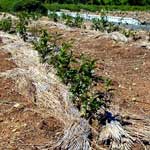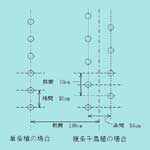Home > Teach me Tea Cha! > Tea Cultivation > How to start cultivating tea
Main content starts here.
How to start cultivating tea
Primarily, tea cultivation was introduced to Japan by the Buddhist priests who had returned from China after their overseas study of Buddhism. At the time cultivation was started from the seeds. However in that way, the quality of tea can be varied depending on the tree. Today, in order to cultivate high quality tea evenly, it is common to take the branch out from the qualified tea trees and plant a cutting. 1. (The procedure of planting cuttings) It is best to plant cuttings between end of June and early July. Some area in Kyushu plant cuttings can be done in fall, but that requires high skill. 2. Find a parent tea tree. Select the trees which have not been harvested. 3. Prepare the soil. Water control is most difficult part of tea cultivation. However, by selecting the soil carefully, watering could be much easier and less stressful. It is recommended to use equal amount of Akadama soil and Kanuma soil. However, similar characteristic soil can be also replaced as long as they have good drainage and keep moist fairly well. When the soil from the farm is used, put them through a sieve (1.5m), and then sterilize the soil before using it. 4. Prepare the cutting. Trim the cutting, and leave only 2 sections and 2 tea leaves. When they are taking away from the parent tree, it is recommended to take the one from the lower part. The cutting should be reasonably thick and solid. 5. Watering Kansui (pour plenty of water) should be done at first. If the weather is fine, try to give plenty of water once a day for a month, and then reduce the amount of water little by little. 6. Other (1)Water supply--- necessary (2)Shade----30-40% sunlight is only needed. Prepare something to make shade such as Yoshizu. (3)Wind protection---Surround around the trees. (4)Temperature---The temperature of the ground needs to be more than 15 degrees Celsius During the summer, be careful with the ventilation. When the temperature of the ground exceed 40 degrees Celsius, the trees easily withered. (Transplanting) Saplings should be transplanted to the farm during the winter or between March to April. Pay attention to the roots and not to damage them, and transplant them as soon as possible. After finishing the transplanting, water the plenty of water, and cover the soil with straws to keep the moisture in the soil. Cut off the part of sapling higher than 20 cm. Leave more than 10 tea leaves. At flatland, line the saplings to the direction of South-North. At hillside, to avoid an outflow of soil, line the saplings to contour line. There are various ways to line the saplings, but Tanjyou and Fukujyuchidori ways are most commonly used. Tanjyo style has been used for a long time. When electrical plucker is used for the harvest, Tanjyou style cultivation is often used. The advantage of Tanjyou style is that it makes possible to use less amount of saplings at the large land and produce high amount of tea. Disadvantage is it requires 5 years to be ready for the tea cultivation. That means the first 5 years has no profit, and it is hard to say if this type of the farm is really profitable. Getting withered tree is not very good situation to keep the line without the gap, thus this style of farming requires high skill and enough experience. The space between the lines should be 180cm because most of the plucker machines are designed to go through 150 to 180cm space. Space between each saplings should be 30cm, if less space, the trees do not grow properly. Fujukyouchidori style is often seen in Kagoshima prefecture, and now it is getting popular in Shizuoka prefecture as well. It was originally believed not being efficiency. However, it only takes 3 years to get ready for the tea cultivation. Therefore, it is actually as profitable as other style of tea cultivation. The spaces between lines should be 180cm, and leave the gap between trees for 45-50cm.





